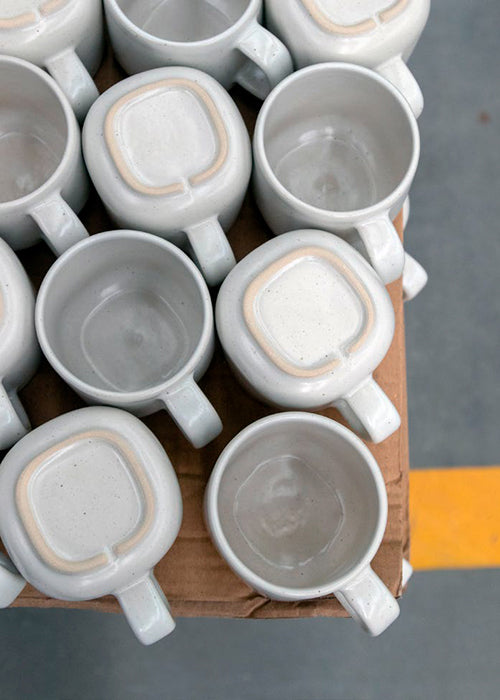In Conversation with Monoware
In Conversation with Monoware
Why did you decide to create a tableware brand?
We started Monoware in response to our struggle to find modern tabletop essentials for the everyday. Overwhelmed by choice and fleeting trends that compromise on quality and design can make it difficult to buy to last.
We felt there was a gap to serve a generation of creative cooks and diverse households who have new needs and habits but consistently value timeless design and durability.
How did you develop the brand concept?
We began by investigating changing living environments and table formalities. It started in conversation with friends and family around the kitchen table about their take on cooking, eating and entertaining. We heard how important mealtimes were to punctuate the day with nourishment and creativity.
We also questioned the conventions of the market. Why are shelves dominated by large dinner sets when households come in all shapes and sizes? What determines glossy white crockery as the popular preferred choice? Why is tableware predominantly bought by women?
Our response is to create a brand that elevates everyday moments at the table with refined staples that blend and grow with individual style. We bridge artisanal character with dependable manufacturing processes. We unlock dinner sets by offering individual pieces, meaning colours can be effortlessly mixed and dishes added at any time.
How would you describe Monoware as a brand?
Monoware creates timeless tools for the table defined by simple, elegant forms, a natural colour palette and effortless adaptability. Our mission is to bring beautiful, durable designs to the table for a thoroughly modern way of eating. The recipes might evolve, people may grow and conversations will change, but our tableware is for keeping.
Why did you choose Ian McIntyre for the design, and what brief did you give him?
At Monoware, every project begins with curiosity: how can we improve the objects we use every day? Our collaboration grew from that guiding question.
For each collection, we partner with a specialised designer who has the expertise in the material we want to work with. What appealed to us in Ian’s work is the way he mixes industrial design, traditional craft skills and provenance. On top of that, he has extensive experience working with stoneware, our chosen material to guarantee durability. We are continuing to work with designers who are experts in their craft to develop distinctive new products.
What makes this collection distinctive?
We took our time to get the details right. The collection blends modern and traditional aesthetics. The forms have subtle complexities, for example, soft square profiles that merge into round. This detailing has enabled us to develop a contemporary language that is still rooted in familiar and archetypal forms that have withstood the test of time.
Whether it is the curve of the coffee cup that moulds comfortably into the palm of the hand or the perfect pour on a water jug, we have carefully considered every detail and put it to test through many rounds of prototypes. Taken together, the additional production steps we introduced to achieve our shapes and glazes are what makes this collection distinctive.
What are the inspirations behind the glazes?
It is hard to underestimate the difference a glaze makes to a ceramic object. Working with glaze technicians and natural references, we experimented with countless colours, textures and finishes until we settled on choices that felt distinctly Monoware.
We developed a flecked glaze palette which allows for subtle variation within each object – a nod to qualities more commonly associated with studio pottery. Chalk is off-white with an elegant matt finish and a fine dusting of flecks. Pebble is a neutral beige with a texture inspired by smooth rocks. Slate is a cool grey with a slight azure tinge. It is impossible to create a bad mix with any combination of these colours.
How are the ceramic pieces made?
Before the start of the design development in our London studio, we embarked on a road trip through Portugal in search of the perfect pottery. The factory we decided to collaborate with is
a family-run business south of Porto – an area famous for its rich heritage working with clay and high-quality craftsmanship – that sources clay locally and is as exacting as we are.
We opted to use three different production processes to make the collection - slip casting to make the mugs and the pitcher - these shapes have tapered profiles with subtle undercuts, so the moulding process requires more complex moulds than typically found. The bowls and plates are the workhorses of the collection and are made on the jigger jolley which rolls and compresses the clay to reduce warping. The platter is made using a ram press which allows us to design large non-concentric forms.
To create each piece, the clay is hand-poured into our specially crafted moulds. Once the pieces are dried, they are dipped into our glazes and run through a single firing system which is heated up to 1180℃, making our pieces strong and durable. A single firing system minimises emissions and has less impact on the environment.
What do you hope for Monoware in the future?
One of the joys of launching has been the opportunity to talk to many more people. The past year has brought acute attention to the importance of our home environments and the daily objects we use. For many, cooking has provided a window of creativity and agency. Listening to these signals will continue to directly influence how we expand our range of modern tableware staples with collaborators in different design disciplines. We foresee a family of goods which perfectly complement each and embody our vision of a table set for life.
Thank you to Daniel and Jassim for taking the time to speak to us. Last year we spoke to Ian McIntyre about the re-engineering of the iconic Brown Betty teapot, which can be read here









